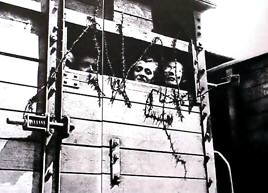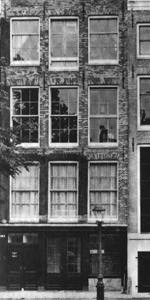The Holocaust
Holocaust History
QUICK FACTS
 The
people were lulled into a false security. They were told that they were
going to different places, better conditions, work camps, on and on and
on.
The
people were lulled into a false security. They were told that they were
going to different places, better conditions, work camps, on and on and
on.
| The transports were usually cattle cars. At times, the floor of the car had a layer of quick lime which burned the feet of the human cargo. |

| There was no water. There was no food. There was no toilet, no ventilation. Some boxcars had up to 150 people stuffed into them. It did not matter if it was summer, winter, boiling hot or freezing cold. And an average transport took about four and a half days. |
 Sometimes
the Germans did not have enough cars to make it worth their while to do
a major shipment of Jews to the camps, so the victims were stuck in a
switching yard - "standing room only" - for two and a half days.
Sometimes
the Germans did not have enough cars to make it worth their while to do
a major shipment of Jews to the camps, so the victims were stuck in a
switching yard - "standing room only" - for two and a half days.
There were many people back then that refused to go to the Concentration Camps so they went into hiding. One family that went into hiding is The "Anne Frank" Family.
Anne Frank was one of the Jewish victims of Nazi
persecution during the second world war. After Nazi
 Germany
invaded the Netherlands in 1940, increasingly severe anti-Jewish
measures began here as well. The Frank family tried to escape by going
into hiding. On July 1942, Otto Frank, Edith Frank-Hollander and their
daughters Margot and Anne hid in this building on the Prinsengracht.
They where later joined by Mr. and Mrs Daan, their sun Peter and Mr.
Dussel. The building consists of two parts : a front house and a back
annex. Otto Frank's business was located in the front house. The
uppermost floors of the back anexe became the hiding place. After more
than two years the group was betrayed and deported. Anne and Margot died
of typhus in Bergen-Belsen in March 1945, only a few weeks before this
concentration camp was liberated. Otto Frank, the only member of the
group to survive, returned after the war.
Germany
invaded the Netherlands in 1940, increasingly severe anti-Jewish
measures began here as well. The Frank family tried to escape by going
into hiding. On July 1942, Otto Frank, Edith Frank-Hollander and their
daughters Margot and Anne hid in this building on the Prinsengracht.
They where later joined by Mr. and Mrs Daan, their sun Peter and Mr.
Dussel. The building consists of two parts : a front house and a back
annex. Otto Frank's business was located in the front house. The
uppermost floors of the back anexe became the hiding place. After more
than two years the group was betrayed and deported. Anne and Margot died
of typhus in Bergen-Belsen in March 1945, only a few weeks before this
concentration camp was liberated. Otto Frank, the only member of the
group to survive, returned after the war.
During the hiding period Anne Frank kept a diary. In it
she described daily life in the back anexe, the isolation and the fear of discovery. Anne's diary
survived the war: after the betrayal it was found by Miep Gies, one of
the helpers. When it was confirmed that Anne would not be returning,
Miep gave the manuscripts to Otto Frank. In 1947 the first Dutch edition
appeared. Since then the diary has been published in more then 55
languages.
back anexe, the isolation and the fear of discovery. Anne's diary
survived the war: after the betrayal it was found by Miep Gies, one of
the helpers. When it was confirmed that Anne would not be returning,
Miep gave the manuscripts to Otto Frank. In 1947 the first Dutch edition
appeared. Since then the diary has been published in more then 55
languages.
For more Holocaust History go to http://www.holocaustcenter.org/ or go to a search engine and search "Holocaust History".
Copyright ©2006 The Holocaust